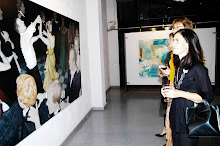
Nina Nolte – An Insight of Paradise
Mario Virgilio Montañez
The work of Nina Nolte is, strange as it may seem, utopian. She portraits a universe prior to the expulsion of Paradise, with clothes and attidudes strictly contemporary, just like the masters of Renaissance and Baroque, who painted characters from the mythologie or the Bible with garments and gestures of their time. We find in Nina´s work a inalienable will based on two principles: figuration - censured so many times and even considered finished - and contemporanity. But at the same time never losing sight of her edenic vision of mankind. Looking at her canvas and in spite of the discredit of painting in general, in favour of more recent and less conventional artistic techniques, no one could ever think that the subject has a dark side. Furthermore, that innocence does not translate into candour, but serenity, dignity, like in the wonderful portraits with a trait that owes as much to Ingrès as tu Dürer. That is to say, in the awareness of the prime of life and in the promises of the moment.
Lets go to do an excercise of fiction: imagine Eve on the first day of her life, lets see her walk towards the Tree of Good and Evill. In her hands not the fateful apple, but a brush or a pencil. Around the tree – dangerous but with sweet fruits – we see marigolds agitated by the joyous flight of the bees. And Nina will paint them, as if it was the portrait of a duke of the Quattrocento, but with pure and vibrant colours. And then, “God saw that it was all good”, continuing with the genesis style, Eve will go to her partner, under a brilliant sun and she will also paint him. This is exactly how any spectator can have access to Nina Nolte´s painting., a unique key to enter her paradise of perfect purity.
In debt as she to her german heritage, there is a rigour directly inherited from the Neue Sachlichkeit (New Objectivity), of which it takes a preference for the definition of shapes, fot its exactitude, but without the bitter elements, sometimes even sour of this movement. We could even say that Nina Nolte submerges the paintings of the New Objectivity in the californian swimming pools, flooded wit the comforting sun reflections of David Hockney. Examples of this concept are the canvases entitled Cherubini, but it can also be applied to her great format portraits. The result is astonishing: a reality that declines the hyperrealist´small details, but that represents the prime of the bodies, the spotless dignity, the simple elegance, the essentiality of flesh, the celebration of the moment. This eternal instant: when there is a sparkle in the glasses and the bottles stop as if they were acquitted of being emptied.
Everything, in this world of vertigo and bustle, is to be grateful for. As if her canvases redeemed us from our mistakes and faults. Becouse painting is an image stopped in time, and it opens – when it´s a work of quality – a window to eternity, to a fixed and still time. In the case of Nina Nolte, this is eternity, it is understood as motionless and timeless – something that quite remarkable in her paintings. She offers us flowers and people, landscapes and plants, animals and models posing proud or relaxed, and always confident. This way, Nina makes of every motif, of every subject a hypnotic piece, enhanced by the natural coloured backgrounds that create chromatic effects inside the best pop painting. Thus, each one of her canvases becomes a votif painting, an icon sacredly lay, an opportunity to discover the beauty that rests, stealthy, in every object, in every person, without renouncing to the psychological depth that we can find in pop artists such as Alex Katz.
As Lucrecio said, there are teardrops in things (sunt lacrymae rerum), and that vision is what we can apply, without going off the german tradition, to the expressionism. On the other hand, a high contemporary poet from Málaga, Rafael Inglada, asked us “to serve together with the arrows, the birds”. And precisely, this is what Nina does, she offers us the birds, but alive and dazzling, before the shot of the arrow. Like in the portrait of the hen Emma, that over the backdrop of the sunset flaunts a presence that more than poultry will correspond to a dragon. Between misfortune and celebration, Nina opts for feasting the senses, the exaltation of life and the presence of beauty. As if it was in the Garden Eden. We are before an innocent look focused on the innocent before the snake started to slide quietly on the grass, a grass in which the first footsteps are those of Nina Nolte.
Nina Nolte is represented by PUNZMANN GALLERY: www.punzmann-gallery.com, Tel 952 787 787.

Keine Kommentare:
Kommentar veröffentlichen